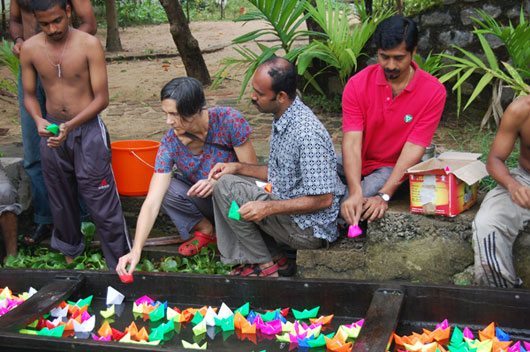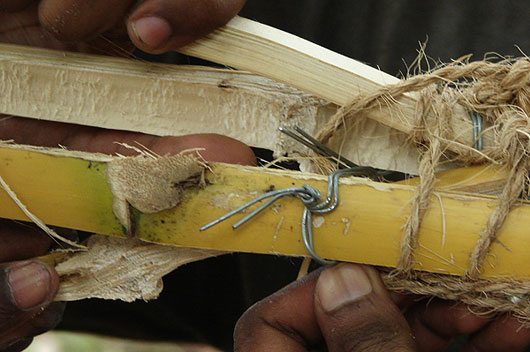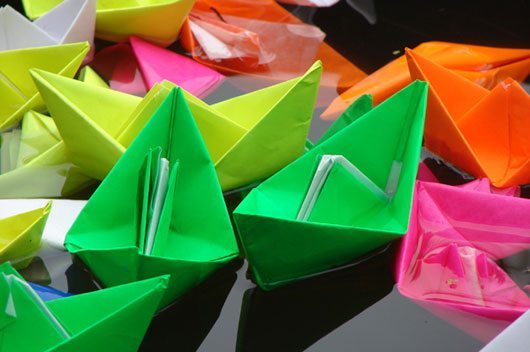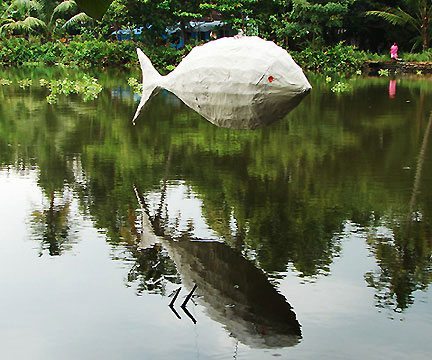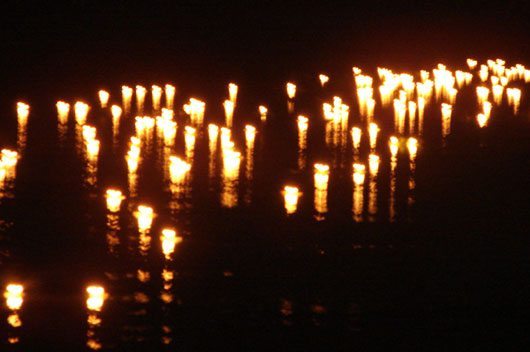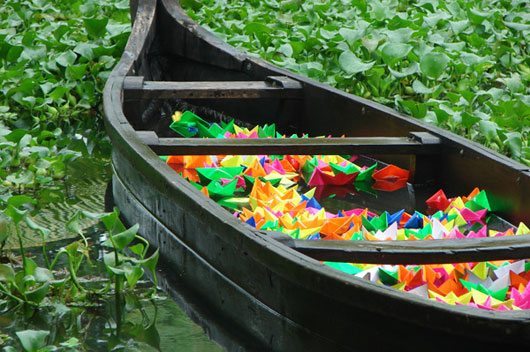Location: Kerala, India
I. A BEGINNING IN KERALA
IT IS OCTOBER 2008 AND I AM THE SOLE woman in a group of ten accomplished artists and art students in the backwaters of Kerala in the south of India. I do not speak the Malayalam language. Everyone knows English, yet we are shy, and my accent is difficult for the students especially. I am trying not to be too US-American, although no respectable woman from this area would be in a situation like this. I cannot drink the water nor eat much of the food, and I have no reasonable access to restaurants or stores. Nevertheless, we spend five deeply gratifying days together, making collaborative, ephemeral art in an estuary, the highlight to date in my ecoart career.
By road we are 12 miles north of busy, commercial Cochin, on the island village of Cheriyam Thuruthu. Here the Arabian Sea meets Vembanad Lake and many great rivers of Kerala. Artist-lecturers Shijo Jacob and Sunil A.P. have made all of the logistical arrangements with students Amal M., Aneesh V., Manjunath K.P., Pavel Suresh, Prajeesh P.P., Shijeesh K. and Shyne K., of the Raja Ravi Varma College of Fine Arts in Mavelikara. Our gracious host, Antony Caral, is also an artist keen to explore with us. Many people have supported the trip during its development, some of whom come and go during the week.
Two years earlier I had started a small non-profit arts organization called Beauty of Water, with a mission of generating collaborative art experiences on the theme of appreciation for water in communities around the world. I wanted the artmaking to be culturally situated yet collaborative from conception through completion. I pictured an exhibit traveling the globe some years hence (a component of the overall vision that I have since let go of), with community-created art pieces from eight countries showing different responses to the theme of appreciation for water. The whole idea seemed fun and simple. I started in India because friend there supported me while Beauty of Water matured enough to take its first steps.
My first year in Kerala was spent forming relationships with artists and cultural creatives in the mountains, villages and cities of this artistically and water rich state. People I met initially assumed I was well connected, knowledgeable, and had a lot of funding, none of which was true. When they came to see that I was conducting a grand experiment, seeking collaborators rather than granting works, authentic connections formed with those whose interest remained. Adventurous colleagues began sharing a sense of excitement for the possibilities that a collaborative approach to an environmental theme might bring, even though Beauty of Water had no finished work yet to point to.
Latha Kurien Rajeev was one of my first friends, and what an extraordinary woman she is. Film producer, curator, wife of a celebrated film director, mother of two bright children, and art lecturer at the College of Fine Arts in Trivandrum, are only a few of the items on her resume. Latha and I dreamed up fantastic ideas for Beauty of Water projects, strategizing and straining for months. We wanted to work with local funders and leaders, and hoped to inspire a groundswell of interest. Those we spoke with received our ideas with encouraging positivity, yet nothing moved into a production stage. Still, we were generating curiosity, and our efforts were well invested.
II. MULTI-FACETED LEARNING SERIES
ONE MORNING IN EARLY 2008 I MET WITH N.N. Rimzon, artist and Principal at R.R.Varma College. We sat at a popular ayurvedic restaurant in Kerala’s capital city of Trivandrum while I proposed a learning series. To my delight Rimzon immediately nodded with understanding. Fifteen minutes later the plan was in place. I was invited to come to Mavelikara and start collaborating with the staff at the college.
We had no money. Just as in the USA, there was precious little funding for this public arts college. Through an accounting glitch I had thought that Beauty of Water possessed a thousand dollars more than the mere six hundred that was actually in the bank. Ignorance is bliss! We went forth assuming everything would fall into place and for the most part it magically did.
Faculty members Shijo Jacob, A.P. Sunilkumar, and Preeti Joseph came up with a structure that fit with the school schedule, and recruited participants. We started the learning series in July and worked in a loose format through September, bringing in four visiting experts and taking one trip. Latha taught about conceptual art and ecoart, and touched on ancient land art in India created long before the term ecoart was in use. Saratchandran, sadly since deceased, screened one of his films documenting the successful struggle against a Coca Cola bottling plant in a region to the north of us in Kerala. Earth-focused contemporary artist Rajan Krishnan delighted students with tales of his artistic path. And scientist Dr. PS Harikumar grounded the series in basic information about water issues Kerala faces, including privatization, industrial contamination, human consumption of heavy metals from polluted water, and more. A majority of the student population voluntarily participated, with 40 to 140 showing up for each lecture.
One day we visited a Ramsar-protected freshwater lake, Sasthamkotta, with 25 students. When some of us arrived late to the site, we found Shijo and Sunil facilitating a brilliant, spontaneous piece that evolved into a performance, integrating a longstanding children’s tradition involving small paper boats. The visual effect was stunning, and participants seemed reverent and happy creating this ritual. Here we began to relate to water viscerally, personally, and as a group.
III. BACK TO THE BACKWATERS
THE BACKWATERS WORKSHOP WAS THE CULMINATING component of the learning series. During our first night onsite I sensed that everyone was quietly excited. After traveling by bus, train, and slim wooden boat Antony paddled for us, carrying loaves of bread, chapatti dinners, a few art materials, cameras, my laptop and secret stash of snacks that later got co-opted by ants, we gathered in Antony’s living room, barefoot and eager, ready to figure out why we were here.
Each student shared something, translated for me by Shijo or Sunil, or in shy yet expressive English. Several said that they had been unclear about Beauty of Water, the learning series and larger project. They could not previously relate to it, had not thought about water much, and did not understand the point of the work. Over time, though, an understanding had emerged and they were beginning to integrate the experiences and lectures. They were expanding their sense of the meaning of water.
I revealed my plan to offer activities meant to help us get out of our thinking minds and into sensory perception and beyond. I felt that we needed to gain information and energy from this place through non-cognitive means, integrating findings with art making, discussion and reflection. I shared more about why I was doing this project, and my thrill in starting this work with them. Each of us, I am quite sure, finished the evening still holding a different idea about the week ahead. Both tired and stimulated, we eventually turned in.
I was honored with a remote room on the second floor of Antony’s home, where I had the gift of solitude and tree tops: gentle breezes flowing through palm fronds. The air was humid and soft, and cool enough for blue jeans each night. Floral scents filled the air. I was warned to bring my shoes inside so the goats would not claim them as a midnight snack.
A half-minute walk away on an earthen path brought me to the production site, kitchen and sleeping quarters for all seven students. A local man named Jacob cooked all of our meals for five days (for which I paid him a total of $45). Here at the water’s edge the land was alive with plants, birds, crickets, and animals I could hear but not identify. Still, it was exceptionally serene, owing to the backwaters themselves and the lifestyle built around these waters. With a constant in and out flow of the water, mosquitoes did not breed.
On our first morning Sunil had a brilliant idea for a phenomenological study of water: we took Antony’s half-shell, pre-made fiberglass boats out for a float. Those with stamina and balance performed pole-pushing to move us along while the rest of us experienced subtle motions of the water. Later Antony suggested body art pieces, after which Manjunath commented that he felt his body being a part of art rather than something he uses to make art. Shyne etched into the skin of Shijeesh’s back, creating a fish imprint. When it sprinkled, Manjunath noticed water on the hairs of his arm becoming beads of light.
Time rolled tenderly from day to night. Small boats were cut from banana tree stalks to hold candles and float on the estuary, recalling rituals honoring water found elsewhere in India and abroad. Shijo called back the paper boat concept we had done at Sasthamkotta Lake, this time with brightly colored papers. An enormous paper maché fish appeared one morning, suspended over its own reflection; later it was lit from inside, swaying under a misty full moon. Water hyacinth filled Antony’s boats which were towed by oarsmen in the wooden canoe, a poetic enigma. A group story game produces this dreamy tale: ‘I run out and go to the railway station. My train passes over the rivers, seas, valleys, etc., finally reaching an island. At that time a beautiful bird takes me and goes into heaven. I see heaven close up. After the journey I return to the college but nobody, no friends, recognize me. I walked on my hands upside down. Then everybody recognizes me again. I see a light again and I go to the railway station to start a journey again. Then I realize it’s a life cycle. I just passed the lifecycle within a few minutes.’
IV. UNDERBELLY
FRICTION POKED THROUGH AMONG LEADERS. Shijo, Sunil and I shared a goal of empowering the students and sparking their creativity, but we had different ideas about how best to do that. Eventually we made agreements. I felt honored by their honesty and exhilarated by our ability to stick with our purpose, even through painful moments.
Group discussions were uncertain fare for me. I felt it was critical for everyone to be empowered to contribute, and I encouraged people to speak in Malayalam so that they could be more comfortable and fluid. But this meant that I did not know what was happening much of the time. Ever intending cultural sensitivity, it was difficult to know how to proceed. I hoped for an exchange of ideas and participatory decision making, and held space for this to my best abilities yet who was I to advocate this style?
I found out later that I came across as sharply critical of others when advocating for my style of collaboration. I also came to learn that many of the ideas for art pieces came from the leaders and students produced them. Credit for creative input arose as an issue among adults after the workshop, and I received harsh criticism on this topic. It is certainly true that we would not have had a workshop without the work of my colleagues, start to finish. I continue to wonder how to have done things better.
It is hard to know what role spoken language played in these challenges. I have learned, though, that any time one is in leadership, even shared leadership, condemnation happens. I did my best to receive negative feedback openly while remaining attentive to the deeper truth that was being birthed.
On top of these complications, daytime heat and humidity drained me. Jacob cooked extraordinary meals but I was missing vital nutrients. I did not want to be greedy or wasteful, so I did not advocate for boiled water as often as I needed it, either. Each day I became weaker, eventually barely able to move around. Sharing these woes is cathartic. I did not have an outlet at the time.
One night I awoke to find a hand-sized spider blocking my path to the bathroom. I love nature, grew up in the woods, and deal with most fears like a grown up. But spiders are in another category. With deep shame and a dubious sense of pride I managed the spider situation on my own, and went on with life.
One morning while I still had energy, I took a walk offsite. The trees at Antony’s were wonderful, providing shade from the sun and shelter from the rain, yet I yearned for open sky. Out on the mud roads the backwaters and rice paddies were flat. The horizon was low, and though the air was hazy, vast green and blue strokes of land and sky revitalized me. Local people in this rural neighborhood gazed at me in wonder. A six foot tall white woman in jeans was utterly foreign. (Things are changing so fast in India that this would likely not be the spectacle that it was in 2008.) I retreated to the trees.
My heart was heaviest on the day we created the boat filled with paper boats. While visually this is one of my favorite pieces, and I am grateful that Shijo envisioned this, I cried dry tears (depleted adrenals) at the end. Some of the acid-bright paper was left in the water as people wandered away. I insisted that each piece get fished out and saved to be burned later, sorry to have any waste or impact, which seemed to be seen as ridiculous. I grapple with this stunning art piece still.
On our last day we started early, after a deep and peaceful sleep. Students completed their final piece, a paper maché water vessel with bright fabric water flowing toward the backwaters. Women still carry most of the water in this area, and the vessels are beautifully shaped. This piece evoked the feminine, a quality I was particularly appreciative of at this point. The immense significance of the week’s happenings had dazzled me. Even depleted of energy I was soaring. Beauty of Water had come through the birth canal. We had played like children with the water, and our collaboration was real.
With smiles and contented sighs we journeyed back to our non-workshop lives, changed forever, at least I was. It took me months to restore myself physically, but I will never forget these bright souls with whom I had the extraordinary opportunity to collaborate.
V. BEAUTY OF WATER
BEAUTY OF WATER WAS CONCEIVED IN 2006. I had reached my forties free of kids or a partner, and lengthy corporate and public sector careers were behind me. I was ready to create new meaning. I had a Master’s Degree in Human and Organizational Transformation from the school of Cultural Anthropology and Social Transformation at the California Institute of Integral Studies, which was both as visionary and as impractical as it sounds. With finite personal savings and contributions from a handful of cherished private donors, I hoped to grow Beauty of Water through ongoing, organically formed partnerships.
Somewhere in the early days I connected with Shelley Sacks and began learning about Joseph Beuys and social sculpture, as well as community art and ecoart. These fields clearly informed Beauty of Water, even though I had and still have to catch-up to become knowledgeable about their underpinnings. My own arts training was informal, and centered on improvisational movement and theater, where collaboration is commonly explored.
I also learned along the way of the work of Betsy Damon, as well as that of Jackie Brookner, Basia Irland, Xavier Cortada, Lillian Ball, Aviva Rahmani, Maya Lin, and many others who are working with water, often in collaborations with communities. Many of these brilliant artists inspire as well as remediate, directly healing our habitats and our relationship with the planet. [Please see the Beauty of Water ‘Inspirations’ page for more: http://beautyofwater.org/inspirations.html]. I bow to these artists and all who make a sacrament of their work. Thank you.
In forming Beauty of Water I have held the belief that people’s actions and behaviors arise from collective consciousness, which speaks through imagery and form. Art comes from and goes to this place, as does culture. With this in mind, it seems to me that we can choose what we want to put our imaginal energy into, and doing so is a powerful act. If we cultivate life-affirming creations, and bring these into manifest form, we work as shamans. These are not original ideas. I am sure that many have written about this and explained it better. Anyway, I have hoped that Beauty of Water could be healing for individuals, groups, and the Earth, seeding collective consciousness with intention.
Water is a metaphor for oneness. Beauty of Water aspires to engender the exhilarating sense of oneness that is the fabric of existence, whether we notice it or not. I distinguish this from interconnectivity, which is also fascinating and intrinsic, yet conceives us as discreet entities. Oneness is noticeable when we blend with others on an energetic level – that delicious sense of being a part of something greater: a group that tunes in and does something that serves the whole; spot-on unchoreographed dance; team plays; other kinds of community activities when everyone is humming. Why not in fine art processes?
Beauty of Water aims to bring attention to water in positive ways, refreshing and re-activating our primal intimacy with this element. Much focus on water is on water problems. I think it would be good to bring joy, excitement, appreciation, and oneness back into focus as well, so that we get happy when we remember water. I hope Beauty of Water can help animate these principles and passions.
END NOTES
All Photos by Liza Behrendt except for the first photo and section IV photo, by Shijeesh K.

